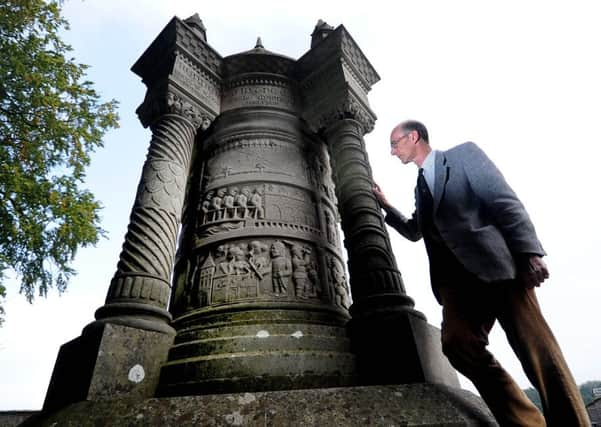The ‘Wolds Wagoners’ who left farms for war


THERE was an early harvest in 1914 and Horace Harrison was, like many other farm workers, toiling in the fields when he was handed his mobilisation papers.
Within a few weeks Harrison and hundreds of fellow wagoners had sailed to France along with the British Expeditionary Force (BEF).
Advertisement
Hide AdAdvertisement
Hide AdMore than 800 of them swapped the peace and tranquillity of the Yorkshire Wolds for the blood and thunder of Flanders fields, and their story epitomises the sense of duty that many have come to associate with the Great War.
The Wolds Wagoners were the brainchild of Sir Mark Sykes, 6th baronet of Sledmere. Sir Mark, whose family had farmed the Wolds for a century and a half, had served with the Green Howards in the Boer War and seen with his own eyes the logistical problems in getting supplies to the front line. He was convinced that in a future European war the Army would need more wagon drivers, as military transport was still largely horse-drawn, and he felt the pole wagon drivers who worked on his land were perfect for overcoming the difficulties he had witnessed.
Sir Mark proposed to the War Office that the agricultural workers of East Yorkshire be signed up as reservist drivers. He eventually got his way and in 1913 the Wagoners’ Special Reserve was set up and the following year when war broke out they became part of the Army Service Corps (ASC).
The men were employees of tenant farmers and Sykes, who owned the majority of the land in the area. Most were Yorkshiremen who came from places like Pickering, Sherburn and Aldborough, but some came from as far away as Essex and Suffolk.
Advertisement
Hide AdAdvertisement
Hide AdSledmere House, in the village of Sledmere, a few miles from Driffield, is home to the Museum of The Wagoners’ Special Reserve. As well as being one of the smallest museums in the country it charts the wagoners’ story. It contains everything from postcards and tin boxes, to rifles and a battered bugle, given to a wagoner.
The museum also holds the hand-written ledger which records the name, age, height and place of birth of all those who signed up.
Martin Watts, the museum’s chairman, says the wagoners were a unique corps.
“These men never got any military training. They were just paid a quid, which they called the ‘silly quid’ because they thought it was daft to give you money to do nothing. But they signed up to be available in case of war.”
Advertisement
Hide AdAdvertisement
Hide AdThey were needed for their driving ability. “We have similar things today, the Army uses civilian doctors and nurses in case of emergency and it was the same with the wagoners.”
To begin with they were stationed behind the front lines, but as the war dragged on they were deployed to front line units and served as part of the infantry and often found themselves in the firing line.
“There’s one man, wagoner Billy Thompson, who came from Middleton just down the road, and he talks about going up to the front line with five other wagoners and two lads from London. They got to the front line trench and one of these Londoners wants to look over the top and in Billy’s words he said, ‘we begged him not to’. He only looked the once and he was shot through the neck.”
A wagoner called Billy Hodgson later described another harrowing experience.
Advertisement
Hide AdAdvertisement
Hide Ad“He recalls driving wagons right up to the front line and he says there was a hollow road with dead Allied soldiers lying in it. He stopped but the person in charge told him to get on with it and he said they had to drive over the dead bodies.”
They themselves weren’t immune from death and of the 800 wagoners who went across to France and Belgium around 80 didn’t return home. “Although they were involved with supply to and from areas of relative safety behind the front line, it was a very dangerous job,” says Watts. “The Germans had their guns aimed at crossroads, bridges and railway lines and they would see some wagons and fire off a few shells.”
Some of the wagoners went for a relatively short time while others spent the whole war out there. “I think their story is a microcosm of every other little rural community, although these chaps were slightly different in that they had volunteered before the war.”
After the war Sir Mark designed a memorial outside Sledmere House in their honour. “It’s a fantastic ‘Trajan’s column’ which tells the story of the wagoners. It really is a one-off.”
Advertisement
Hide AdAdvertisement
Hide AdThe last wagoner died in 1993, but there remains a strong association of wagoners’ families in the Wolds and the tiny museum in the stable yard remains much cherished. “It’s a simple story. They were working in these big open spaces and they’d never been abroad. Going to Bridlington or York was as far as most of them had travelled before, so for many of them it would have been an adventure,” he says.
“They have an everyman feel about them. They were just ordinary folk and they stepped up and served when they were asked to. They were very good at what they did and some of them won medals for gallantry, so they were right in the thick of it.
“They’re important because they remind us that this was a war that affected everybody and people who live in this area still think an awful lot of their wagoners.”
A Wagoners Lecture Evening talk, called East Yorkshire Horse Lads, is being held in the library at Sledmere House, near Driffield, on October 10 at 7.30pm. Tickets cost £10. For more information call 01377 236 637.